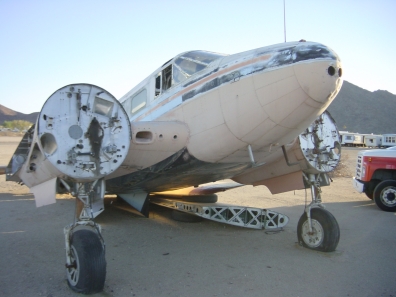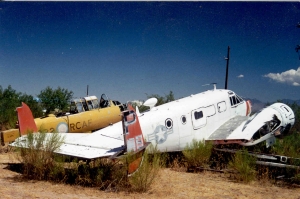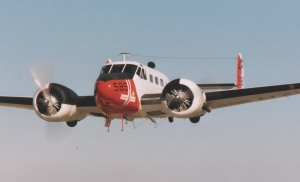Considerations for the Beech
Please Note: The prices below have yet to be updated, but have been left for reference.



So you're thinking of buying a Beech 18, are you? Here are a few things to consider, first.
One of the most appealing aspects of buying a Beech 18 project is usually the cost. There are still a few projects around that can be had for a few thousand dollars, sometimes even a few hundred! The idea getting a Twin Beech for such a small amount of money can be very appealing. It was for me, and that is how I got started messing around with these wonderful aircraft.
Another consideration when you are contemplating a project is what will you end up with when you are done. Is the effort that you are putting into this project worthwhile? If you are thinking about a project as a money making adventure then you need to look at the numbers very closely. It may be hard or impossible to make a profit on a Twin Beech project. You are probably just interested in this project idea because of your love of old airplanes. I know that is how I got started and it hasn't changed over the years. If this is the case, then just throw out those sound accounting principals and get to work on that project!
One of the reasons you can find them so cheap is when you find one of these bargain priced gems, they are usually missing a few parts. Typically these aircraft were flying up until the late 60's and early 70's. They were parked when the final big Airworthiness Directive was issued concerning the wing spar problem. For a big chunk of the Beech 18's, and their military counterparts, were grounded until they could comply with the spar strap requirements. The spar strap kit was a major expense to purchase not to mention the cost required to install it. In many cases this expense was comparable to the value of the aircraft itself. This is why so many aircraft were parked and never flew again. Some were scrapped, some parted out and some were simply parked. Many times the engines and props were sold off and the airframe just sat becoming more and more derelict as time went by. These are the aircraft that are becoming more desirable today as fixer upper projects.
The next issue is the transporation problem. You can't just put this aircraft on a regular trailer and haul it down the road, even with the wings off of it. There's a lot of work to get it prepped and ready for hauling, not even including finding a way to transport it. Click here if you want to learn more about this critical piece to the puzzle.
One of the other important issues is that of purchasing the parts required to complete your project. Hopefully everything is there but if not try to figure out how much it will cost to find all of the missing components. After you add up the numbers you might have a figure that is bigger than the cost of a flying airplane. There is something to be said for buying a flying tired old freight dog and fixing things as you go. Sometimes the motivation factor is higher when you can fly your project between your work sessions.
Parts for the Twin Beech are relatively cheap especially when compared to those of other aircraft. Thanks to the efforts of Dave Warren at Southwestern Aero Exchange parts for the Beech 18 are not only available but are affordable as well. Dave is the biggest and the best source for Beech 18 parts bar none. Not only is Dave the only parts game in town but he and his family are some of the nicest people that you will ever meet. Dave's wife Jan has got to be the best cook in the Southwest. Dave's daughter Shelley always has a friendly and warm greeting. Doug, Dave's brother, is just as nice and helpful as the rest of the family. They are a good bunch of people that those of us in the Twin Beech community owe a debt of gratitude to. If it wasn't for these good folks, parts would be a lot harder to find and a lot more expensive to buy. I will have some more information and photos about Dave's place in the future.
If you are thinking about a Twin Beech project, here are some basic numbers to consider:
The Pratt and Whitney R-985 series prices range from a run out core at $2,500-$15k to full overhauls going well over $60k each. You can find good running mid to high time engines from the core price to the $15-40k range. Your mileage may vary. There are bargains out there to be had but be wary of the engines history. Ask yourself why someone has a low time recent overhaul for such a low price. 500 hours on an engine that has been crop dusting or hauling skydivers may be pretty tired when compared to one off of somebody's Stearman that was flown for pleasure.
Engine mounts and exhaust and accessories are readily available for the Twin Beech. There are several different types of intake and exhaust configurations available. The early style that used the single exhaust stack and dual carb scoops inside the bottom of the cowl is relatively easy to find and can be inexpensive especially in used condition. The later individual exhaust stack and ram air scoops will cost you a lot more. You can still get new exhaust components but the price goes up for the NOS parts. I think that these parts are still cheap compared to any general aviation aircraft today. For a used serviceable set of exhaust and intake components, dishpan, engine mount and accessories you can expect to pay about 2 to $5,000 or more a side. This is where your bargain hunting skills on eBay can come in handy. There are good deals to be had on eBay.
Hamilton Standard props are relatively inexpensive especially when compared to general aviation aircraft. A good used 22D30 prop with Twin Beech blades will cost about $10-25k each. You can still find new old stock props still in the crate, but they have been mostly snapped up. There is an AD on these props that require teardown inspections on a calendar basis which is a low as 18 months up to 60 months. They are great props that are relatively plentiful and are very reliable if checked and inspected regularly.
The Hartzell 3 blade props are a lot more expensive. The new price is well over $35,000 each with used serviceable ones in the $15-30k range. There are bargains to be had here too but watch out for corrosion and proper servicing. If you run Hartzell props on the 985 the engine is subject to additional AD's because the props are hard on crankshafts.
As I mentioned above the Twin Beech has a history of spar troubles. There are many factors that lead to spar problems including corrosion, hard landings and even maintenance. The bottom line is that all Beech 18's are required to have an x-ray to be certain that the spar is okay to begin with and they have to have a strap installed. The x-ray is being done by several folks around the country. These people are supposed to be certified to do this inspection so check their credentials. It has been a while since I have had an x-ray done but as I recall the cost is about $600 to $800. The killer was the travel cost which brought the price up to $2200. I was able to get 5 Beech owners together to have theirs done at the same time. This helped to split the travel cost up among several others.
The strap has to be removed before the x-ray is done. The wings have to be on as well because you have to push up on the wings to help expose cracks. This x-ray is to be done every 1500 flight hours which is a long time or an eternity for some. There are turbine powered Beech's flying insect control in the LA area that fly so much they have to have x-rays each year. There is talk of revising the AD to change from a flight time status to a calendar inspection. I haven't seen anything official on this but I would like to know if you have any information. I believe that this is a good idea as a lot can happen in 1500 hours of flight time. When I first got into Twin Beech's I was told that the spar problems were just because of a few old tired freight airplanes that shed wings and screwed it up for the rest of them. I believed this at the time and didn't pay much attention to this issue until I had a lower spar break on my SNB-1. The only thing that was holding the wing on my aircraft was the strap made by Aerospace Products. Now I am a firm believer in this issue and I inspect my spars during pre flight. This is another reason for my concerns during ground transportation. For more information about spar straps and spar cracking click here.
Most of the C-18 series Twin Beeches (prior to 1946) used either the Goodyear Airwheel balloon tires and multi disc brakes or the more common Bendix 33SC wheels tires and drum style brakes. The Balloon tires are about impossible to find as are the 33SC tires and tubes. If it wasn't for the tires being so hard to find the 33SC is a great way to go. The wheels and brakes are very cheap (I have bought complete brake assemblies new for $25) and they have been very reliable. It might be worth getting a bunch people who need the 33SC tires and tubes together to have a run made. It will be expensive but if the cost can be spread out it might just be feasible. If you have any interest, let me know.
Most of the post war aircraft use the 1100-12 Goodyear wheels, tires and brakes. These are a single disk type of brake that are reliable. Parts are still easily available but are more expensive. Tires usually run anywhere from $350 to $450 each. Brake pucks seem to run about $30 each and 6 are required per side.
These are easy to find and are plentiful. The metalized surfaces are more expensive and can run several thousand dollars each. The basic frames for the fabric covered surfaces are usually several hundred dollars each. Having them recovered is a labor intensive process and this is where the price goes up. Now is the time for you to learn the art of fabric work anyway.
This is a weak area in the Twin Beech. All of the engine controls are push pull controls (wound core rod with an outer spring wound jacket). Over time these controls will tend to freeze up or become very stiff. You might be able to free them up with a good penetrant. The old manuals call for a solution of powdered graphite mixed in with Naphtha. The Naphtha will get the graphite inside the jacket and evaporate leaving the graphite behind. I have had good luck with a Mouse Milk penetrant followed by Tri-Flow. You can also use a Plews oiler and pump the lube in from one end. If you pull the controls out of the aircraft you can put them in a PVC tube full of the penetrant and lube to keep the controls in a submerged environment and just let them soak for awhile. If you use new old stock replacements you should treat them in a similar fashion otherwise you may have stiff "new" controls after a while which is very frustrating considering the difficulty of removing and replacing them. NOS controls are still available although some are rare and are priced accordingly. The cost can range from $50 each to $500 each or more. The typical Twin Beech uses 6 pairs of controls and most are different lengths and strokes.
These Warbirds can be either military stock inside or nice and plush as there is an almost limitless range of ways that a Twin Beech can be configured. I believe that we will see more people trying to restore these Warbirds to their original configuration. More and more are showing up on the Warbird circuit these days.
There are many other mods that some people like and others don't. Everything from one piece plastic windshields and modified wing tips to tall tail wheels and tri cycle landing gear. There is no end to the possible mods but thankfully the trend is turning toward stock and original.
It seems that the Twin Beech aircraft that have had cargo modifications are less desirable and will sell for less when compared to un-modified aircraft. One reason is that the cargo aircraft may have had a harder life with varying standards of maintenance. Cargo Mods include a bigger door in the aft fuselage and a crew door in the side of the cockpit. Other mods are tie down rails and other interior changes. It seems that the stock aircraft with the factory round door and executive interior is the most prized type of configuration. People are cutting stock doors out of airframes to convert their aircraft back to stock.
I am partial to the military aircraft myself. I like the AT-11 Kansan bombardier and gunnery trainer the most because it combines the best of both worlds. The economy of a Twin Beech and the impressive features of a Warbird with a turret, bombs and a glass nose. The AT-11 is one of the most desirable ex military Twin Beech models around today. The majority of the parts are interchangeable between the various models of the Beech 18. The parts that are more difficult to find are those that are specific to the military models. Bombing and gunnery equipment is very hard to come by, and when you do find it they run very expensive. You will have to reproduce a lot of the parts simply because you can't find them. This is true for almost all Warbirds and is not peculiar to the Beech.
For more information about the many different types of Twin Beech, as well as their configuations, try this page.
Well... I think you have picked a great airplane.
They are a lot of fun! Relatively cheap to buy parts for. Classic looking, beautiful aircraft that everyone loves (people will walk right by that Gulfstream 4, 5, 6.2...or whatever it is, and will walk right up to admire your Twin Beech). They are incredibly fun to fly. They can haul a lot of your credit card carrying friends along (to help buy your fuel). They are appreciating in value even through tough economic times. They can operate out of short strips. They make a great stable instrument platform. Your whole family can ride in comfort and style. They are relatively easy to work on and maintain. They also have a good safety record.


Here is a before and after picture of my RC-45J. Beauty is in the eyes of the beholder! Besides having a family, there is nothing more rewarding than breathing life back into a great piece of history that has been sent to the scrap yard. The same people that put that history in the scrap yard, and thought you were crazy to take on such a worthless project, are also the first ones to ask for a ride when it is done.
The only thing left to be said is, good luck with your project!